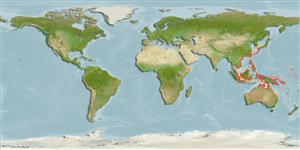Teleostei (teleosts) >
Eupercaria/misc (Various families in series Eupercaria) >
Labridae (Wrasses) > Corinae
Etymology: Pseudocoris: Greek, pseudes = false + Greek, kore = pupil (Ref. 45335).
Environment: milieu / climate zone / depth range / distribution range
Ecology
Marine; reef-associated; depth range 10 - 30 m (Ref. 90102). Subtropical
Distribution
Countries | FAO areas | Ecosystems | Occurrences | Point map | Introductions | Faunafri
Western Pacific: Ryukyu Islands to Indonesia.
Size / Weight / Age
Maturity: Lm ? range ? - ? cm
Max length : 15.0 cm TL male/unsexed; (Ref. 559)
Males distinct with the bright yellow band over the body. Female plain green (Ref. 48636).
Found solitary or in small groups (Ref. 90102) in coastal sand and rubble reef, usually flat substrate with remote coral bommies in current zones. Mixes with various other fishes in open water to feed on zooplankton (Ref. 48636).
Life cycle and mating behavior
Maturity | Reproduction | Spawning | Eggs | Fecundity | Larvae
Oviparous, distinct pairing during breeding (Ref. 205).
Parenti, P. and J.E. Randall, 2000. An annotated checklist of the species of the labroid fish families Labridae and Scaridae. Ichthyol. Bull. J.L.B. Smith Inst. Ichthyol. (68):1-97. (Ref. 35918)
IUCN Red List Status (Ref. 130435)
Threat to humans
Harmless
Human uses
More information
ReferencesAquacultureAquaculture profileStrainsGeneticsElectrophoresesHeritabilityDiseasesProcessingNutrientsMass conversion
Tools
Special reports
Download XML
Internet sources
Estimates based on models
Preferred temperature (Ref.
123201): 23.6 - 29, mean 28 °C (based on 138 cells).
Phylogenetic diversity index (Ref.
82804): PD
50 = 0.5020 [Uniqueness, from 0.5 = low to 2.0 = high].
Bayesian length-weight: a=0.00977 (0.00470 - 0.02030), b=3.07 (2.89 - 3.25), in cm total length, based on LWR estimates for this (Sub)family-body shape (Ref.
93245).
Trophic level (Ref.
69278): 3.4 ±0.45 se; based on food items.
Resilience (Ref.
120179): High, minimum population doubling time less than 15 months (Preliminary K or Fecundity.).
Fishing Vulnerability (Ref.
59153): Low vulnerability (10 of 100).
Nutrients (Ref.
124155): Calcium = 58 [26, 123] mg/100g; Iron = 0.835 [0.448, 1.716] mg/100g; Protein = 19 [16, 21] %; Omega3 = 0.23 [0.12, 0.44] g/100g; Selenium = 10.7 [5.1, 22.7] μg/100g; VitaminA = 134 [39, 562] μg/100g; Zinc = 1.11 [0.69, 1.91] mg/100g (wet weight);
